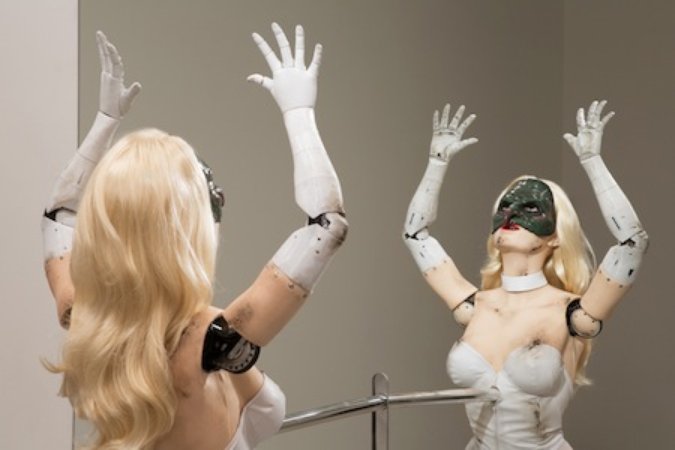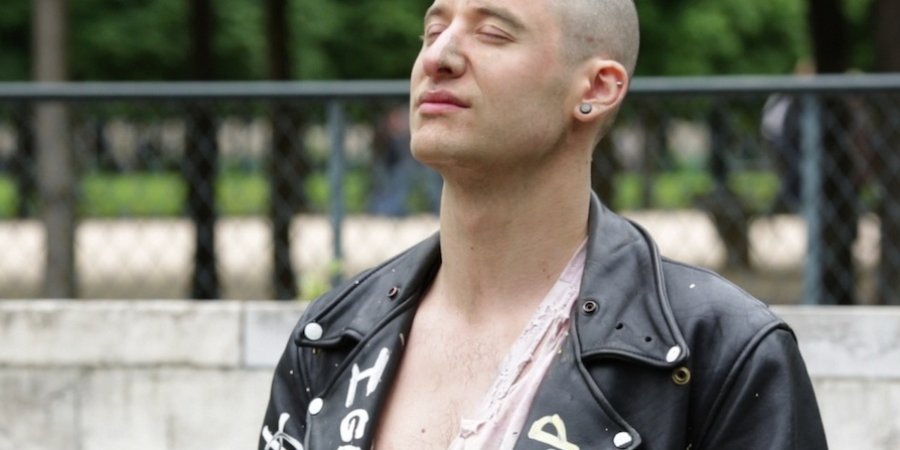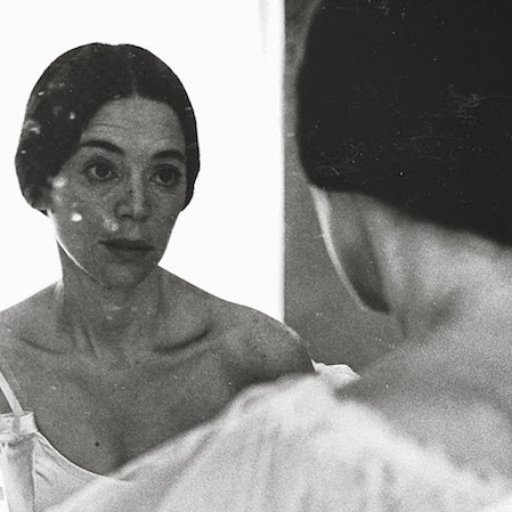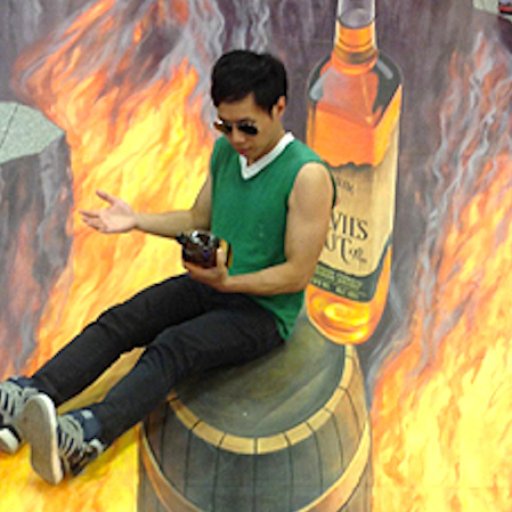There's an mesmerizing aberration at David Zwirner Gallery, a technological siren that, once it locks its fearsome eyes on you, will drag you deep into the Uncanny Valley and feast on your brain. Occupying its own cavelike room in the gallery, which the viewer is encouraged to enter alone, this animatronic sculpture—a buxom blonde woman in a green witch's mask who dances to pop songs while facing a mirror, all the while using facial-recognition technology to follow your eyes—forms the headline-grabbing core of Jordan Wolfson's debut at the blue-chip Chelsea gallery. "Is this the most terrifying robot ever?" asked London's Daily Mail. It's a good question.
Another equally spellbinding component of the show is the 33-year-old artist's 2012 animated film Raspberry Poser, a looping 14-minute melange of Disney-style animation (of a chaotically violent redheaded child), CGI graphics (of a lyrical condom spilling out little red hearts, and of the HIV virus), still images from art history, live-action film (scenes of SoHo, luxury furnishings stores, kids' rooms, under-construction suburban houses, and a vignette of a cliché gutter punk in Paris, played by Wolfson), all tied together by a blaring soundtrack of Mazzy Star's "Fade Into You," Beyoncé's "Beautiful Nightmare," and Roy Orbison's "Only the Lonely." Watching the film is like a narcotized reverie brought on by an overindulgence in pop culture, followed by a queasy hangover of musings on mortality and the triteness of consumer desires. Rounding out the show is a group of hybrid painting-sculptures plastered with odd bumper stickers and disquieting cartoon imagery.
To get some insight into the thinking behind this body of work, and the way the artist—a winner of the Frieze Foundation's Cartier Award and a participant in the 2006 Whitney Biennial—approaches his work, Artspace editor-in-chief Andrew M. Goldstein spoke to him via telephone as he was setting up a new show, a mini survey part of the Glasgow International Arts Festival, curated by Sarah McCory.
Your new show contains two very different pieces, one terrifying and one beautiful. Both of them deal with disjuncture, be it between images and affect, animation and reality, sex and death, and gender and sexuality. Can you talk a little bit about how the show came about?
Originally, I wanted to show Raspberry Poser in New York, and I had spoken to a few galleries that didn’t really follow up with me. Then David wanted to include the work in a group show, but logistically it didn't seem right—the piece was going to come down early because Raymond Pettibon needed to use the space as a studio before his show—and I felt strongly about the artwork. So I told the gallery that I thought they were a great gallery, and that if they'd be interested in just doing a one-off show of the piece and not representing me that would be fine, and we could just see what it’s like working together. But then David and I clicked, and he asked me to join the gallery— it all went very quickly, and was all very positive—and he asked me what I wanted to do. I said I wanted to do this, to work with animatronics, and he said "go for it." I knew it was possible, but I didn’t have the financial resources to do it, and David viewed it as an investment in our collaboration.
 A view of the animatronic sculpture, Female Figure
A view of the animatronic sculpture, Female Figure
The people you collaborated with on your animatronic piece are technicians who work at the absolute vanguard of CGI and Hollywood special effects, and they have even done some work with robotics for the military. How did you find these guys?
I had done a lot of research on how to make an animatronic figure, and I was originally trying to collaborate with a person in England, who would have coordinated a team of people to build the animatronic as a independent contractor. But that didn’t come together because he got a big movie contract, and in any case everyone kept pointing me toward the same company, Spectral Motion—they had the reputation as being the best. So even though I had been trying to find a more affordable way of doing it, I kept coming back to them, and we ended up working together and it was a wonderful collaboration. We had a very positive creative process.
What drew you to using animatronics in your work, which is a really provocative, head-turning approach?
I wasn't at all interested in animatronics until I went on a trip with an artist friend [Alex Israel] to Epcot Center and I saw this animatronic figure of Barack Obama, and another one of Benjamin Franklin and then one of Mark Twain. I remember at a certain point Obama, with his hands by his side, turned his palms up while he was speaking,and extended his fingers in illustration. I thought it was beautiful, and I was so visually moved. It wasn’t so much about them being Obama or Ben Franklin or Mark Twain—it was more the physicality of it. I intuitively felt the physicality from seeing it, and I thought it was transporting. After experiencing that I couldn't help but want to take that physicality and put it into my own work. The feeling was addictive, and I couldn’t get it out of my mind.
How did that experience evolve into the finished piece?
Initially I thought it would be interesting to bring to life one of the characters that had been in my videos and make them present in a room, and that brought up a whole set of different formal questions that I’d have to deal with and which were very exciting and challenging and daunting. One thing I had noticed was that when an animatronic was recorded on video or film, the way film frames an object or subject forces you to look at it a certain way, so that it becomes a visual effect existing only within the frame of the camera—it's not like seeing it in person, where you heard the gears move, you see the skin, and it feels real. So I though, "Oh, I'd like to recreate that. But how do I recreate that?"
Intuitively, almost immediately, I imagined that there would be a mirror the animatronic looks through, creating something that functions as a camera frame for the viewer, so it would be like looking at her image in cinema or off your iPhone or whatever, and it would create that same bridge for the audience. And then she would look at you—from the beginning, the idea was that she would look through the mirror at you and follow you with her eyes as she danced and spoke to you.
 Another view of the sculpture
Another view of the sculpture
The eventual piece, "(Female Figure)," is this psychologically horrifying, abject animatronic woman who gyrates to pop songs while fixing her predatory stare on the viewer. In terms of disjuncture, she's both the witch and snow white at once, a young woman and a crone, male and female, real and fake. Who is this woman?
She’s based on a preexisting cartoon character that I modified. I was interested in the physicality of the female form and how there's a kind of guttural reaction to physical sexuality that I experienced in my looking at women, or looking at bodies in general, the male form included—the way that certain things would arouseor excite me in a primitive way. I was interested in this point of arousal, the way there’s something primal about it but also something binary—not binary in terms of male-female, but in terms of the distortion of arrousal going on and off.
The way these things come about in my mind, they're built out of intuitive flashes, and I immediately saw her wearing a witch's mask, with the mask acting as a kind of formal device—it lets you look at her in a safe way while at the same time crosses out the possibility of looking at her as an object of desire. Another thing I knew early on was that she would have completely matte skin and a cartoony anatomically correct body, but that the mask would be extremely glossy to contrast her skin and her eyes would be shiny and hyperreal in contrast to her body. So there's nothing really real there except her eyes, or maybe the eyes and the hands. Though the mask, too, is real in its own way.
There’s a lot of literature about the gaze in terms of its place in psychology and gender dynamics, but I read that you first became intrigued in this direct gaze by looking at Jeff Koons’s “Made in Heaven” series, where the artist stares very confidently out at the viewer from within these highly charged pornographic scenarios.
Well, that’s not entirely true. I recognized in the “Made in Heaven” series that Jeff Koons was using his gaze as a formal device, which in my interpretation provided a kind of passage or safety to the viewer in looking. But in 2009, I had actually done a performance for the Frieze Art Fair where I had these physicists leading tours around the fair during which they would talk about string theory with one participant at a time, and then those tours got transcribed and were re-enacted by two young actors playing a male-and-female teenage couple. I remember the tests for reenactments never quite working right, nothing seemed to work, and then one day in Regent’s Park I said, "Ok now both of you guys just stare into my eyes and read from the transcript." When they read from the transcript and acted the two different parts—the male would look at the viewer with hostility, and the female would look at the viewer flirtatiously—it created a formal bridge that allowed for something to travel between the artwork and the viewer. It was indiscriminate and nonjudgmental, and I realized anything could travel between the artwork and the viewer as long as this bridge of connection was in place.
 An installation view of Raspberry Poser
An installation view of Raspberry Poser
Music is also a central part of your work, lending your pieces a kind of pop-hook catchiness that worms its way into the audience's mind and lodges your pieces there. In your catalogue, though, one of your essayists describes the songs you choose as intentionally "cheesy." Do you agree? How do you choose your music?
I think that the music I choose is really beautiful. I’ll listen to a song, and I’ll really consider it for a long time, but then I’ll kind of get hooked on something and I can’t stop listening to it and I just intuitively see the artwork with this song. The music and imagery kind of get bound together, or cut up and taped together, in my head. For example, while making Raspberry Poser I had been listening to a lot of Roy Orbison, and I had been struggling with how I was going to edit the punk into the video. Then one day I remember driving into Brooklyn listening to “Only the Lonely,” and the cut happened inside my head, and I went home and I just cut it like that and it fit together perfectly with my vision of how it would be.
That’s pretty much how I work with the music. But at risk of sounding like a conceptual artist, I also think that it’s interesting to take something out of culture that in a lot of ways was made by culture—to take this byproduct of culture, which is what I consider a lot of this pop music to be, and then to recycle it by fertilizing my work with it. I feel the act of simply taking and not changing is radical.
So you're using songs as a kind of found object?
Yes, it's something I’m just taking, as if I was taking something off your shelf. It’s the act of grabbing, of taking, and having it change inherently through its use in the artwork. It’s not about license or copyright, or about musicality, or the curation of music. My intention is to take something as if it grew out of the natural world.
You also often work with poetry, prominently incorporating Richard Brautigan's "Love Poem" in Animation, Masks, for instance. Your animatronic piece begins with a jarring line, spoken by the witchy dancer in your own voice: "My mothers dead, my fathers dead, I'm gay, I'd like to be a poet. This is my house." Where did the dialogue in that piece come from?
I wrote all the dialogue—there’s nothing quoted. When I say “my mother’s dead, my father’s dead,” I’m not only speaking about my mother and my father, I’m letting go of expectations. But they did both get sick this year and some of that probably came in. What I really mean is that when you say goodbye to your parents or your origin, you become free, and that’s what this piece is really about, letting go of conformity. And by saying “I’m gay,” that’s more about the idea of trying something on—though I have to admit I've got questions about sexuality. When I say, "I'd like to be a poet," I'm saying this is all poetry, these are just words, this isn’t me—and I don’t believe I am my art. My art certainly comes from me, but this isn’t me, you know? This is me talking with you now in this interview, but the artwork is a separate composition that exists entirely on its own.
 A still from Raspberry Poser
A still from Raspberry Poser
This idea of identity as being this theatrical, changeable construct seems to recur in your work, like in Raspberry Poser, where you have this raging, suicidal redheaded kid who keeps morphing into different things and killing himself in different ways. Who is this kid?
He’s a character I found, this hysterically angry child cartoon, and I started using him in my artwork. He was originally a copyright-free form that I bought, and I liked that he had this kind of frequency—a high frequency of anger—that I was interested in, so I started working with my animators to make him do all sorts of different things. I was interested using the frequency of anger as a kind of formal element, as a high-sound, high-pitched, high-energy component in the artwork.
 A still from Animation, Masks
A still from Animation, Masks
This kind of angst and extremity is something that gives your work its edge, as with Animation, Masks, where the shylock-esque character begins by alternately pointing his fingers cocked in a gun shape at his head and the viewer while morphing across these grotesque anti-semitic caricatures.
It’s funny, because I don’t think that animation is grotesque—I think it’s beautiful. It's a strange image, and I understand that it's a caricature, I think if you tried to look at it from an anti-semitic reading you’d be disappointed, and that if you looked at Raspberry Poser for a kind of personal or identity-politics meaning you’d be disappointed, and that if you looked at the animatronic female figure for gender politics that you would also be disappointed. The thing about these artworks is that they're always about a distorted form, but the distorted form is just an external factor, and inside that is the intention behind the work. And the intention is a very positive one—all the works have very positive intentions behind them. They're not about hatred and they don’t propagate hatred. I think they’re about witnessing culture. It’s like, I consider myself a witness to culture, not a judge. And I come from culture, I'm born into culture, the world is polluted—that pollution is inside my body, it’s inside my mind, and these are the images that come out of my mind.
 A still from Raspberry Poser
A still from Raspberry Poser
One of the most striking elements of Raspberry Poser is the way you incorporate animations of the HIV virus, seen as exuberant, almost childlike CGI renderings that bounce on the beds of luxury furnishing stores and frolic in the streets of SoHo. Can you talk about how it plays into the film?
I think it comes from the witnessing I was talking about. When I was growing up we had mandatory health class in school, where we were taught to fear of the HIV virus with our entire body. It was rarely discussed it as a homosexual phenoneom, and I think that probably goes back to my two questions in Raspberry Poser ["Do you think I'm rich? Do you think I'm homosexual?"]. I suffered a huge amount of anxiety from this, and I feel the HIV virus in the film is surfacing from that anxiety. The other thing we were taught about was global warming, and that’s what I remember from being a kid—learning about global warming and being taught to have a nearly hysterical fear of AIDS.
 Another still from Raspberry Poser
Another still from Raspberry Poser
You've said before that "there is no story" in your work. How do you want your pieces to be read? As fugues, as tone poems? For instance, how do the virus and the punk character and the redheaded kid in Raspberry Poser interrelate?
They don’t, but they do through the formal composition of the artwork, and the formal composition of the artwork generates some meaning. It’s out of control, and it’s out of my control and your control. We’re both viewers of this, and I’m simply finding the solution of how to put it together, and then both of us are watching it. Does that make sense? The form is generative—form generates meaning. Because form is action, and the action implies something. The meaning comes across on its own through a kind of indifference, like in the natural world. And it can’t be judged. The minute you try to change or correct it, it becomes contrived, and it becomes polluted by intention and over-deliberateness.
 A still from Raspberry Poser
A still from Raspberry Poser
It's interesting to me that we're now a little more than a century away from the time when Picasso and Braque used cubism to fracture the picture plane and address the technological upheavals of their day—and collage is still such an important tool that we're again using today to do exactly the same thing. It strikes me that what you're doing in your films especially, but even in your animatronic piece, is a kind of cross-platform collage that conveys a very contemporary sensibility, not even necessarily because of the technology that’s used but because of this flattened, magpie way of seeing we have today that's been filtered through the Internet. How does the Internet play into what you’re doing.
It’s funny, because I think of the Internet as being the same as running water, or a refrigerator. It’s part of my life, and it’s an extension of my mind and my body in a way. It’s only when we don’t have the Internet that we start to panic, because so much of our lives are documented, recorded, and organized through it. But I think what the Internet does is that it magnifies cultural symptoms, though I can’t claim to have an advanced philosophical position on the Internet. I consider myself a user of the Internet like anyone else, and I'm living in this world, and I'm working with it very actively. Information gets passed, absorbed, developed, and distorted very quickly through the Internet. It’s like a kind of hyper-generative body, essentially.
 An installation view of the David Zwirner show>
An installation view of the David Zwirner show>
The mantra of your Zwirner show seems to be "touch is love," a phrase that appears on several of the paintings and that is used in the animatronic sequence. What does that phrase mean to you?
It actually comes from a John Lennon song—“touch is love/love is touch.” I made a bumper sticker from that because I thought "touch is love" has a certain kind of frequency and it moved me, and then that “touch is hate” has another kind of frequency, and I was interested in the contrast between these two frequencies—the negative and positive. I'm interested in making compositions from these contrasts, so that’s what those sculptures in the center room were about. I was interested in different types of frequencies in language, which is all form. Form doesn’t just exist in a line quality, it also exists in an exclamation point, or a negative word, or a positive word, with all of these things acting as notes that can be be put together in a kind of musical composition, or compositions of different types of frequencies.
So, your show at Zwirner was undeniably a sensation. What are you working on next?
I’m getting ready to make a new piece, and I’m thinking about it right now. I feel lucky to have been given an opportunity to make this show at David Zwirner, and I feel really fortunate to have been able to make the animatronic. I’m excited about opening things up creatively in a way, and continuing to express how I see the world—I think that’s just what an artist wants to do, and I’d be fine doing it from anywhere. I feel generally lucky right now, and humbled by this experience, and happy I can share the work with an audience. And I’m excited about making art. I can’t wait—I’m gonna make a whole world of art.
























